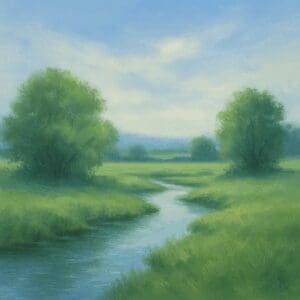In the world of art, there is nothing quite like the raw beauty of nature and the thrill of attempting to capture that beauty on canvas. Among the variety of mediums available, acrylics stand out due to their versatility and vibrant colours. Today, we’ll be discussing how you can sketch out a landscape for painting in acrylics.
**Step 1: Observation**
Every great piece of art begins with careful observation. Spend time in your chosen landscape and try to absorb its essence. Note the varying shades of colour, the way light interacts with objects, the subtle nuances of the scene that make it unique. If possible, take pictures from different angles and at various times of the day. These will serve as valuable references.
**Step 2: Thumbnail Sketches**
Start with simple thumbnail sketches to experiment with composition. These miniatures allow you to play with different views, perspectives, and focal points without investing too much time or resources. Experiment with the Rule of Thirds, creating balance, and ensuring your painting has a clear point of interest. This stage is critical to forming the foundation of your final piece.
**Step 3: Full-Scale Sketch**
Once you’re satisfied with a thumbnail, scale it up into a full-size sketch on your canvas. Use light pencil lines that can be easily covered with paint. The sketch doesn’t need to be overly detailed; it is just to guide your painting process.
**Step 4: Value Study**
A value study is a grayscale version of your sketch, focusing purely on the lights and darks in your landscape. This step is crucial to understanding how to translate the three-dimensional world onto a two-dimensional canvas. It aids in highlighting the areas where you want to direct attention, bringing depth and contrast into the composition.
**Step 5: Choosing the Right Colours**
One of the key strengths of acrylics is their broad and vibrant colour range. Select a colour palette that reflects the mood of the scene. If you’re aiming for a warm sunset scene, consider rich oranges, reds, and purples. For a serene morning landscape, you might choose cool blues, whites, and greens. Always keep your colour harmony in mind.
**Step 6: Blocking In**
Start applying paint to your canvas, beginning with the larger shapes and broader colour areas. This is known as ‘blocking in’. Use your value study to guide your application of light and dark shades. Remember, acrylic paints dry darker than when they’re wet, so adjust your palette accordingly.
**Step 7: Adding Details and Texture**
With your basic shapes and colours in place, start adding smaller details, textures, and highlights. Use a variety of brushes and techniques, such as dry-brushing, glazing, and impasto to create different effects. Remember, nature is not perfect; irregularities can add a touch of realism to your painting.
**Step 8: Review and Adjust**
Finally, step back and review your painting. Look at it from different angles and distances. This will give you a fresh perspective and help you identify areas that need adjustment. Make any final tweaks necessary, but remember that sometimes, less is more.
Sketching out a landscape for acrylic painting is a step-by-step process that requires time, patience, and observation. It’s a journey, with each step informing the next, and every mistake becoming an opportunity to learn. As you grow as an artist, you will develop your own techniques and style.
Remember, IrishArtMart.ie is here to support your journey with a diverse range of acrylic paints, canvases, brushes, and other art materials. Now, venture forth, and let the beauty of the world inspire you to create your masterpiece!
Disclaimer: The views and opinions expressed in this article do not necessarily reflect the official policy or position of Irish Artmart.





